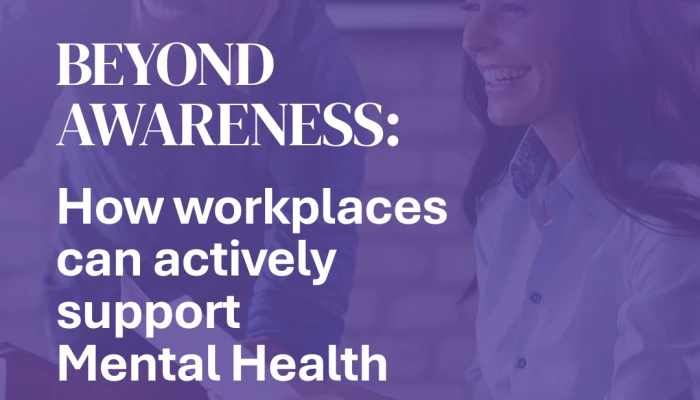When crisis arrives at your desk: a leader’s guide to supporting colleagues (and yourself) through trauma
You’re midway through reviewing quarterly reports when Marita appears at your office door. Her hands are shaking, her face pale. “Have you got a moment?” she manages. “I think I need to go home.”
In that moment, your spreadsheets become irrelevant. What matters is the human being in front of you who needs support – and your ability to provide it.
This scenario, or variations of it, plays out increasingly in workplaces every day. A team member’s response to news of a family emergency, the aftermath of witnessing something distressing, or the weight of an ongoing personal crisis can all break through professional facades at any moment, just as an acute mental health crisis (like a panic attack or depressive episode) can. Neither trauma nor mental health issues fall in behind the protocols of office hours or deadlines.
The hidden weight we carry
I recently spoke with a leader who described watching a usually composed team member suddenly break down after receiving news that her hometown was under siege. “She’d been checking her phone obsessively for weeks,” he said. “We all noticed something was off, but nobody knew how to approach it. When the crisis hit, we were completely unprepared.”
The reality is that trauma can impact anybody, anytime. It’s essentially a physical and/or psychological injury as a result of a very frightening, distressing or damaging impact event. And in our current climate of global uncertainty, these impact events – whether they be conflicts, economic pressures, natural disasters or personal crises – are more likely than ever to hit close to home unexpectedly and test our resilience.
When we consider that more than 25% of us are struggling with mental health challenges at any given time, in addition to the increased prevalence of trauma, this means the likelihood of encountering a colleague in acute distress has never been higher.

Understanding what you’re seeing
Trauma and acute mental health challenges manifest differently in everyone. Some people become hypervigilant, jumping at unexpected sounds or struggling with open office environments. Others experience cognitive fog – difficulty concentrating, memory problems, or trouble making decisions that once came easily. You might notice emotional dysregulation: overreactions to feedback, interpersonal conflicts, or conversely, an unsettling emotional numbness.
One finance director described how trauma affected her team member’s work: “Tasks that used to take him an hour were stretching into days. He’d avoid certain meetings without explanation. It wasn’t until months later we learned he’d lost a sibling in circumstances similar to a project we were working on. Every presentation was re-triggering his grief.”
A framework for response
When crisis arrives at your doorstep, or desk, having a structured approach can mean the difference between helpful support and well-intentioned harm. The key principles involve:
- Creating stability through presence: Your composed demeanour matters more than perfect words. Stand or sit at their level, keep your voice low and steady. Sometimes simply saying “I’m here” while clearing away gathering crowds can provide the anchor someone needs.
- Focusing on immediate needs: Rather than investigating what happened, ask solution-focused questions: “What do you need right now?”, “Would you like to sit down?” and eventually, “Are you getting any professional support for this, seeing a doctor or similar?” These practical queries help move from panic to action.
- Offering simple choices: Providing options returns a sense of control. “Would you like water or tea?” “Should we move somewhere private?” Two or three choices maximum – overwhelm is already at capacity.
- Taking appropriate action: If someone’s at risk, don’t hesitate. This might mean having someone call for support while you stay present, connecting them with employee assistance programmes, or ensuring safe transport home.
Real moments, real responses
Consider Amir, a typically stellar performer who starts missing deadlines after he started experiencing heightened anxiety levels. Instead of going straight in for a performance conversation, his manager sits with him privately, asks what support would help, offers flexible working arrangements, and immediately connects him with counselling resources. The performance conversation can still happen, but it needs to be kept separate and involve advice, preferably from your HR team.
Or picture the team meeting where news breaks about redundancies at a competitor – where many have friends. Rather than pushing through the agenda, the leader pauses, acknowledges the elephant in the room, validates concerns, and offers to reconvene after giving people time to process.

The wider ripple: secondary trauma
Here’s what we often miss: trauma is contagious. When you support someone through crisis, it’s normal to absorb some of their distress. This can translate into vicarious trauma, which is particularly common in high-pressure environments where emotional labour is part of the job.
A managing partner at a law firm described it perfectly: “After six months of supporting my firm through various crises while managing my own family challenges, I realised I was experiencing their trauma symptoms. I couldn’t sleep, felt constantly on edge, and started avoiding certain conversations altogether.”
This isn’t weakness – it’s human. And recognising it is the first step to maintaining your own capacity to help.
Protecting your own foundation: extended self-care strategies
Supporting others through trauma requires robust self-care practices. Here’s what I‘ve found to be effective for leaders managing this invisible burden:
Immediate recovery techniques:
- after difficult conversations, take five minutes to physically reset – walk to a different floor, step outside, or simply change your physical position
- practise the emotional shower – visualise washing off the day’s emotional residue before leaving work
- keep a transition ritual – listening to specific music on your commute, changing clothes immediately when home, or taking three deep breaths before entering your house.
Weekly maintenance:
- schedule processing time just as you would any meeting – use it to journal, reflect, or simply sit quietly
- maintain at least one activity completely unrelated to work where you’re not 'the leader' – a pottery class, book club, or sports team
- build in buffer zones around intense periods – if you know difficult conversations are coming, don't stack your calendar.
Check-ins:
- regular supervision or peer support groups specifically for discussing challenging situations
- professional coaching focused on emotional resilience, not just performance
- body work that releases physical tension – massage, acupuncture, or physiotherapy.
Quarterly resets:
- take genuine breaks where you're completely unreachable – even 48 hours of true disconnection can restore depleted reserves
- audit your emotional load – are you carrying responsibilities that aren't yours? what can be redistributed?
- seek professional support proactively, not just reactively. Regular maintenance therapy sessions prevent crisis.
The physical foundation
Sleep isn’t negotiable when you’re supporting others through trauma. Neither is nutrition. A senior HR director shared with me once: “I started treating my physical health like a professional responsibility. If I’m depleted, I can’t hold space for anyone else's crisis.”
This means:
- protecting sleep boundaries vigilantly (but not obsessively)
- keeping water and healthy snacks accessible during high-stress periods
- maintaining exercise routines even when – especially when – things are chaotic
- limiting alcohol, which might seem to help but actually disrupts the emotional processing needed after difficult days.
The quiet revolution of trauma-informed leadership
Being trauma-informed doesn't mean becoming everyone's therapist. It means recognising that the humans we work with are whole people carrying invisible weights, and sometimes those weights become unbearable.
It means replacing “What’s wrong with you?” with “What happened to you?” It means creating psychological safety where people can be human without sacrificing professionalism. It means understanding that supporting someone through crisis isn't a distraction from business – it’s an investment in sustainable performance.
Building your mental health crisis and trauma response capability
The gap between leaders who freeze (and some who even get angry, but that’s for another article) and those who provide genuine support often comes down to preparation. You wouldn't wait for a fire to learn evacuation procedures. Similarly, crisis response skills need cultivation before they're needed.
Structured leadership training programs like Trauma-informed care for HR leaders and ActNow: mental health crisis response, which combines evidence-based frameworks with practical scenarios, help leaders develop confidence in recognising and responding to acute mental health issues and trauma while maintaining their own wellbeing. Through facilitated workshops, participants gain practical tools they can apply immediately when crisis strikes.
Contact us today to discuss some trauma-informed leadership training options for your organisation.


